ASM Metals HandBook Vol. 8 - Mechanical Testing and Evaluation
Подождите немного. Документ загружается.

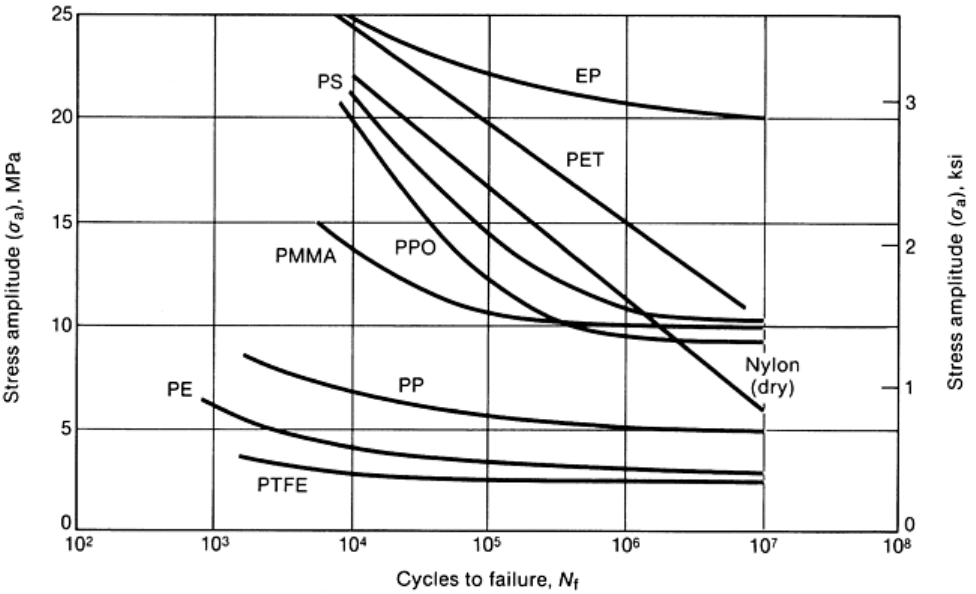
where σ
max
is the maximum stress and σ
min
is the minimum stress of the fatigue cycle. The stress amplitude,
also denoted as S, is generally plotted against the number of cycles to failure, N, on a linear-log scale, which is
called an S-N plot. A general trait of these plots is that the number of cycles to failure increases as the stress
amplitude is reduced. In some polymers, there is a critical stress level, often referred to as the endurance limit
of the material, below which the specimen does not fail in less than 10
7
cycles.
Figure 2 shows the S-N behavior of several commodity plastics. It should be noted that nylon and polyethylene
terephthalate (PET) do not exhibit an endurance limit. Other plastics—including polyethylene (PE),
polypropylene oxide (PPO), polystyrene (PS), polytetrafluoro-ethylene (PTFE), polypropylene (PP),
polymethyl-methacrylate (PMMA), and epoxy (EP)—exhibit a stress limit below which failure does not occur
in less than 107 cycles for these testing conditions. Because plastics are sensitive to many factors including
frequency, temperature, mean stress, and molecular structure, the fatigue test conditions must closely mimic the
service conditions of the polymeric component. Despite the simple nature of these experimental tests, the S-N
approach is widely accepted in the engineering plastics community for design applications where stress
concentrations are expected to be minimal or where the fatigue life of the component is likely to be dominated
by the nucleation of a crack.
Fig. 2 Stress amplitude versus cycles to failure, or S-N behavior, of several commodity plastics
Displacement and Strain-Based Loading. While stress-based tests are appropriate for the evaluation of plastics
chosen for load-controlled applications, these tests might not be suitable for circumstances where the structural
component is likely to experience fluctuations in displacement or strain. In such instances, strain- or
displacement-based tests might be more appropriate. In such tests, the configuration typically is based on a
fixed cantilever subjected to repeated constant deflection. The initial stress range will typically decay under
cyclic loading (much like a stress relaxation experiment) and is caused by plastic deformation or softening of
the polymer. Hysteretic heating from deformation can further result in an inaccurate prediction of the cyclic
stress amplitude (Ref 9). However, because stresses generally decay in this type of test, thermal failures are
rarely encountered (Ref 5).
Strain-based tests are often utilized for components with accumulated strain or blunt notches (Ref 5). The
majority of strain-based fatigue tests are performed using fully reversed loading conditions, generally
accompanied by a cyclic softening phenomena in plastics (Ref 2, 9). Under cyclic strain conditions, the fatigue
response is best characterized by the cyclic stress-strain curve. This curve is created by testing several
specimens subjected to a range of controlled cyclic strain limits. Tests are continued for each specimen until the
hysteresis loops become saturated. A curve is fit through the amplitude of these saturated hysteresis loops in

order to establish a cyclic stress-strain curve. Figure 3 shows a comparison of the cyclic and monotonic stress-
strain curves for several polymers. An interesting feature of these polymers is that they all soften and exhibit
lower yield points under cyclic strain than under monotonic conditions (as opposed to metals, which can exhibit
either cyclic softening or cyclic hardening).
Fig. 3 Comparison of the cyclic and monotonic stress-strain curves for several polymers. Source: Ref 2
The cyclic strain life data can also be portrayed in a manner analogous to the S-N approach. The total strain
amplitude can be divided into elastic and plastic strain amplitude components. The strain amplitude of the
fatigue cycle is plotted against the number of cycles or load reversals to failure, which provides an empirical
relationship between the strain amplitude of the fatigue cycle and the number of cycles to specimen failure (Ref
6):
(Eq 2)
Here, ε
a
is the strain amplitude, σ′
f
is the strength coefficient, 2N
f
is the number of load reversals to failure, ε′
f
is
the ductility coefficient, and b and c are material constants. The first term on the right side of Eq 2 is the elastic
component of the strain amplitude, and the second term is the plastic component of the strain amplitude. Tests
dominated by the elastic component of strain are considered high-cycle fatigue with little plastic strain. Low-

cycle fatigue tests are identified by the relatively small number of cycles or reversals to failure and the large
degree of plastic strain.
An important concern in the testing of polymers is that the attributes of the fatigue test are crucial to the relative
ranking of fatigue resistance among various polymers. For example, polymers with higher damping capacities
can be less resistant to fatigue. These polymers experience thermal heating when tested under constant stress
amplitude. Conversely, these same polymers can have enhanced fatigue resistance if tested under constant
deflection conditions. Moreover, the relative placement of fatigue resistance in polymers correlates strongly to
whether the tests are performed under adiabatic or isothermal conditions (Ref 5).
Thermal Fatigue and Hysteretic Heating. Due to the viscoelastic nature of polymeric solids, a portion of the
strain energy dissipates under cyclic loading conditions. This heat generation results in an increase in specimen
temperature until the heat generated per cycle is equal to the heat dissipated through conduction, convection,
and radiation. The temperature of the specimen depends strongly on the frequency of the test, the amplitude of
the applied stress or strain, and the damping properties of the polymer. In some instances, especially in
unnotched specimens, the temperature of the polymer specimen can locally surpass the glass transition or flow
temperature of the polymer. Ferry (Ref 9) has found that the energy dissipated per second, , is given by:
= πνJ″(ν, T, σ)σ
2
(Eq 3)
where ν is the frequency, J″ is the loss compliance, T is temperature, and σ is the peak stress of the fatigue
cycle. The rate of change of temperature for adiabatic heating conditions in which the heat generated is
transferred into temperature rise is given as:
(Eq 4)
where ρ is the mass density and C
p
is the heat capacity of the polymer. In general, the increase in temperature
will scale with increase in frequency, stress amplitude, and internal friction of the polymer. Figure 4 shows the
thermal fatigue behavior of polyacetal and its dependence on test frequency. The temperature rise in the
specimen can be monitored with a thermal couple or an infrared sensor. In many polymer systems, the thermal
work influenced by high damping and low thermal conductivity contributes to micromechanisms of permanent
deformation including craze formation, shear bands, voids, or even microcracks (Ref 8).

Fig. 4 Plot showing the effect of increasing test frequency and stress amplitude on the fatigue failure of
polyacetal
The hysteresis loops observed under cyclic loading conditions can provide useful insight into micromechanisms
of fatigue damage. Figure 5 shows the hysteresis loops after various numbers of fatigue cycles in both high
impact polystyrene (HIPS) and acrylonitrile butadiene-styrene (ABS). An interesting observation is that the
hysteresis loops are symmetric for ABS, while the hysteresis loops become much larger for the tensile portion
of the fatigue cycle in HIPS as the fatigue test progresses. These events are understandable considering ABS
undergoes shear yielding mechanisms and the HIPS undergoes crazing that requires a tensile component of
stress. Crazing results from fibrillation or polymeric drawing ahead of the fatigue flaw. The advancement of the
craze zone is associated with damage accumulation in the leading fibrils; thus, the tensile portion of the
hysteresis loop grows as damage accumulates in the specimen.

Fig. 5 Hysteresis loops after various numbers of fatigue cycles in both high impact polystyrene (HIPS)
(bottom) and acrylonitrile butadiene styrene (ABS) (top). Note the lack of symmetry in the HIPS due to
crazing mechanisms. See text for discussion.
References cited in this section
2. P. Beardmore and S. Rabinowitz, Treat. Mater. Sci. Technol., Vol 6, 1975, p 267
5. R.W. Hertzberg and J.A. Manson, Fatigue of Engineering Plastics, Academic Press, 1980
6. R.W. Hertzberg and J.A. Manson, in Encyclopedia of Polymer Science and Engineering, Wiley, 1986, p
378
8. J.A. Sauer and M. Hara, Advances in Polymer Science 91/92, H.H. Kausch, Ed., Springer-Verlag, 1990,
p 71
9. J.D. Ferry, Viscoelastic Properties of Polymers, Wiley, 1961
Fatigue Testing and Behavior of Plastics
Lisa A. Pruitt, University of California at Berkeley
Fatigue Crack Propagation
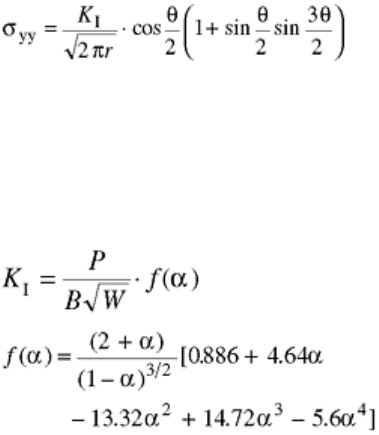
Fracture Mechanics Concepts and the Defect-Tolerant Philosophy. The use of fracture mechanics for fatigue
design is based on the tacit assumption that structural components are intrinsically flawed and capable of
sustaining a considerable amount of stable crack growth before failure. The fatigue life of a component based
on this defect-tolerant approach is dictated by the number of loading cycles needed to propagate a crack of an
initial size to a critical dimension. Fracture mechanics is used widely in the characterization of fatigue crack
propagation behavior of advanced engineering plastics capable of sustaining a substantial subcritical crack
growth prior to fracture. Fracture mechanics is also used in safety-critical applications where defect-tolerant life
estimates are essential. Characterizing crack growth behavior in polymers can be complicated by fatigue cracks
known to propagate at different rates depending on the near-tip damage micromechanisms, mean stress,
frequency, or test environment. These factors are of significant interest and practicality for the safe design of
structural polymeric components subjected to repetitive loading.
The stress intensity factor, K, derived from linear elastic fracture mechanics, is the parameter used to describe
the magnitude of the stresses, strains, and displacements in the region ahead of the crack tip. The linear elastic
solution (Fig. 6) for the normal stress, σ
yy
, in the opening mode of loading is written as a function of distance, r,
and angle, θ, away from the crack tip (Ref 10):
(Eq 5)
where K
I
is the mode I (opening mode) stress intensity factor. This parameter incorporates the boundary
conditions of the cracked body and is a function of loading, crack length, and geometry. The stress intensity
factor can be found for a wide range of specimen types and is used to scale the effect of the far-field load, crack
length, and geometry of the flawed component. Standard specimens employed in fatigue crack propagation
studies are the single-edge-notch specimen (Fig. 7a) and the compact-tension specimen (Fig. 7b). The form of
the stress intensity factor for the compact-tension geometry is given as (Ref 10):
(Eq 6)
where P is the remote far-field load, B is the specimen thickness, W is the width, and α is the ratio a/W that
increases as the fatigue crack, a, advances in length.
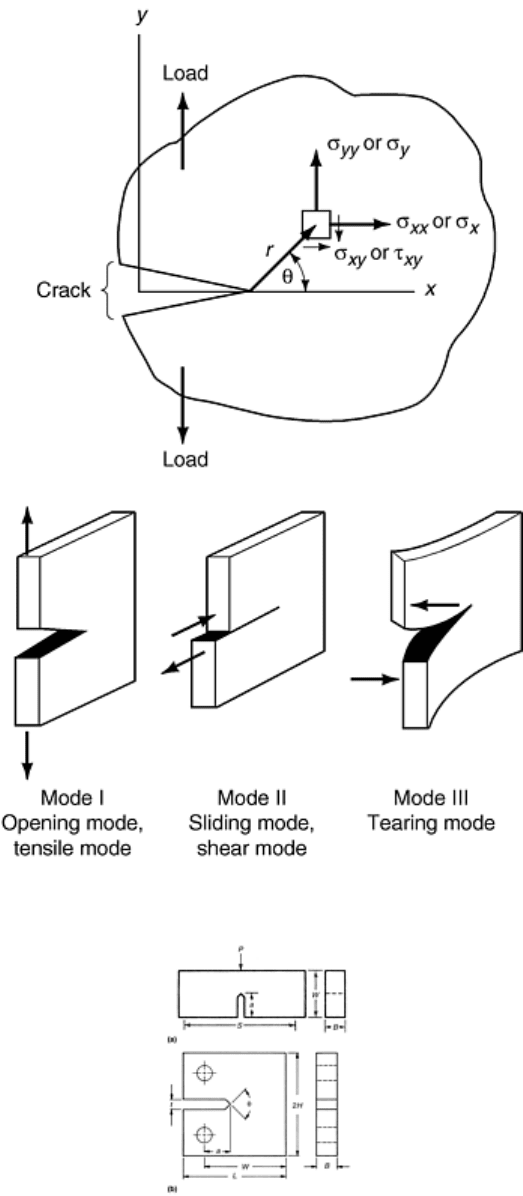
Fig. 6 Coordinate system for crack-tip stresses in mode I loading (see Eq 5)
Fig. 7 Specimens employed in fatigue crack propagation studies. (a) Single-edge-notch specimen. (b)
Compact-tension specimen
Regimes of Fatigue Crack Propagation. Fracture mechanics provides a design approach for predicting the life of
a cracked structural component under cyclic loading conditions. While the micromechanisms of deformation
differ for metals, polymers, and ceramics, the fatigue crack propagation behavior of these materials share many
macroscopic similarities. As with crystalline materials, there are three distinct regimes of crack propagation for
polymers under constant amplitude cyclic loading conditions. These regimes include the slow crack growth or
threshold regime, the intermediate crack growth or Paris regime, and the rapid crack growth or fast fracture
regime (Fig. 8). The velocity of an advancing fatigue crack subjected to a constant stress amplitude loading is
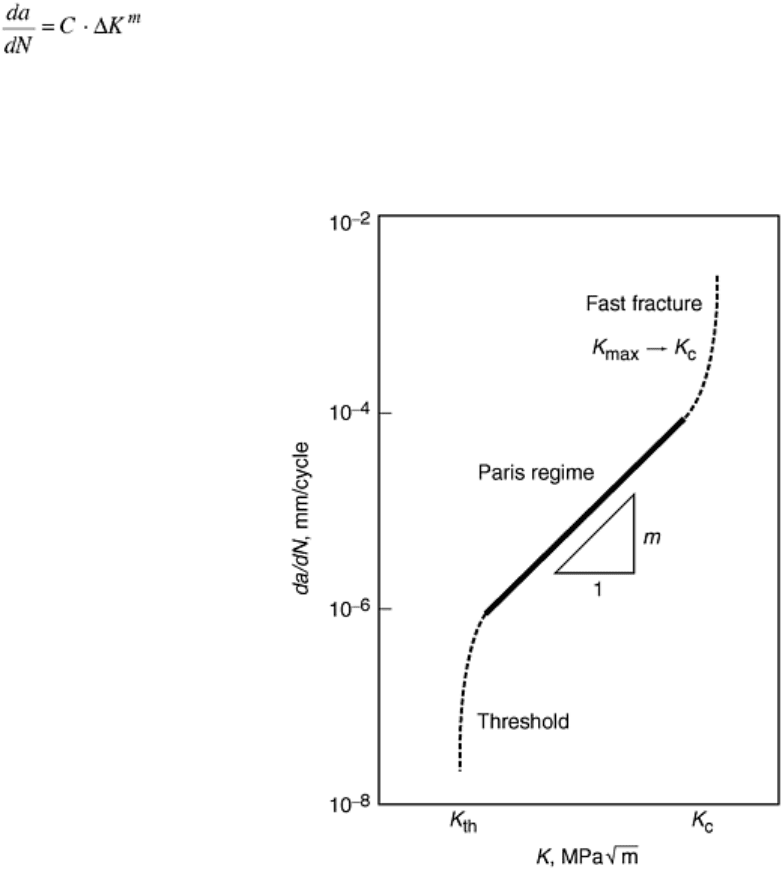
determined from the change in crack length, a, as a function of the number of loading cycles, N. The fatigue
crack propagation rate per cycle, da/dN, is found from experimentally generated curves, in which a is plotted as
a function of N. For constant amplitude loading, the rate of crack growth increases as the crack grows longer.
Paris et al. (Ref 11) suggested that the stress intensity factor range, ΔK = K
max
- K
min
, which captures the far-
field cyclic stress, crack length, and geometry, should be the characteristic driving parameter for fatigue crack
propagation. This basis of the Paris relationship states that da/dN scales with ΔK through the power law
relationship:
(Eq 7)
where C and m are empirical constants. These constants can be strongly affected by polymer morphology, test
frequency, stress ratio (the stress ratio, R, is defined as the ratio of the minimum stress to the maximum stress of
the fatigue cycle) of the fatigue cycle, as well as by test temperature and environment. Figure 8 shows that the
Paris equation is valid for intermediate ΔK levels spanning crack propagation rates from approximately 10
-6
to
10
-4
mm/cycle.
Fig. 8 Schematic illustration of the three distinct regimes of crack propagation rate observed in fatigue
testing under constant amplitude loading conditions. For polymers, typical values of m range from 3 to
50 depending on the polymer system.
The Paris relationship is a useful tool for fatigue life prediction. It is implied in this defect-tolerant approach
that all structural components are intrinsically flawed with an initial crack size, a
i
. Assuming the fatigue loading
is performed under constant stress amplitude conditions, the geometric factor, f(α), does not change within the
limits of integration. Fracture occurs when the crack reaches a critical value, a
c
, the Paris equation can be
integrated to predict the fatigue life of the component:
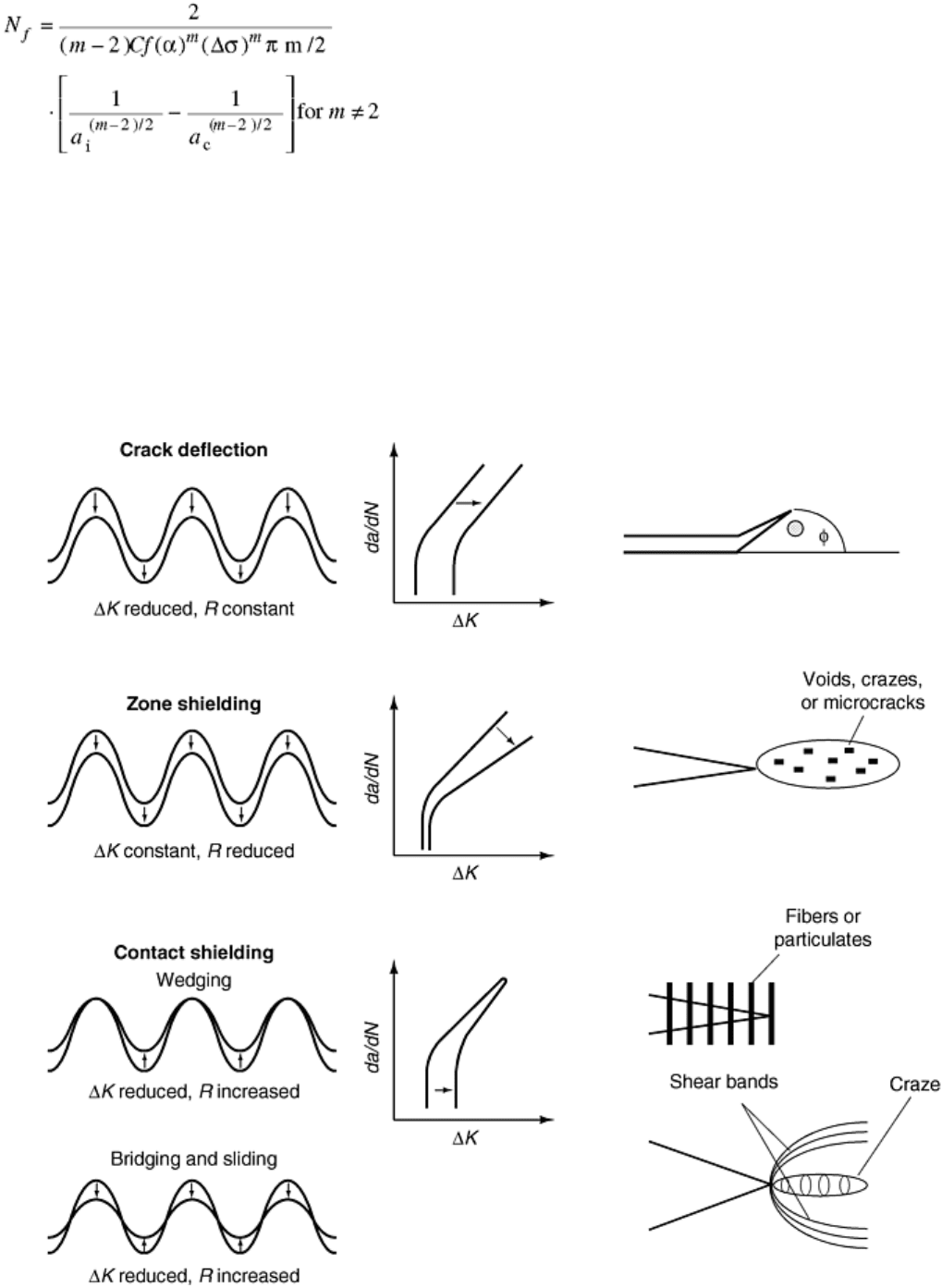
(Eq 8)
Crack Shielding Mechanisms in Polymers. The crack driving force near a fatigue crack tip, ΔK
tip
, will be lower
than the “applied” crack driving force, ΔK
a
, when extrinsic toughening mechanisms are present. The presence
of extrinsic toughening mechanisms shields the crack tip, thereby decreasing the crack driving force and the
crack growth rate. Ritchie (Ref 12) has expressed the extrinsic crack-tip shielding effect:
ΔK
tip
= ΔK
a
- K
s
(Eq 9)
where K
s
is the stress intensity factor due to shielding. Under cyclic loading conditions, there are three general
types of shielding mechanisms: crack deflection, process zone shielding, and contact shielding (Fig. 9).
Shielding due to crack path deflection results in improvements in the fatigue crack propagation behavior over
all ranges of ΔK. By contrast, process zone shielding mechanisms operate more effectively at high ΔK levels,
whereas contact shielding mechanisms are more effective at low ΔK levels.
Fig. 9 Schematic illustration of the three types of shielding mechanisms: crack deflection, zone shielding,
and contact shielding
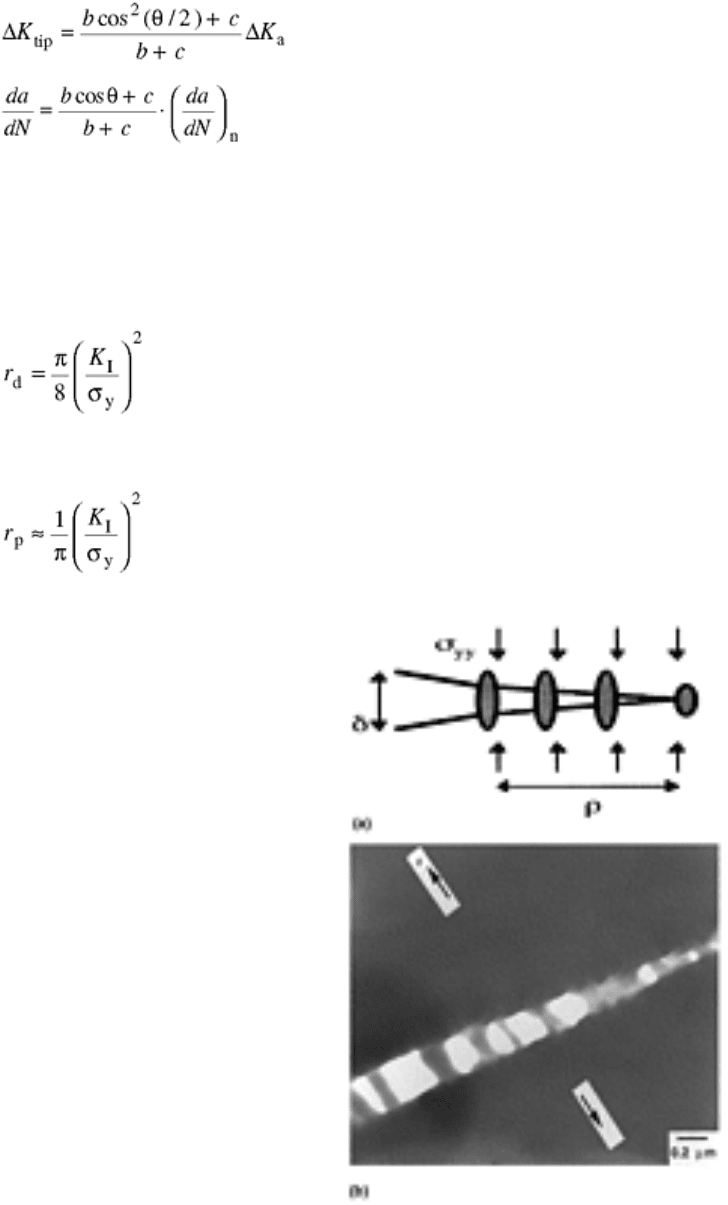
The amount of shielding due to crack path deflection has been modeled by Suresh (Ref 13). Suresh derived the
effective fatigue crack driving force and subsequent crack growth rates by analyzing a small segment of the
crack with an out-of-plane deflection:
(Eq 10)
(Eq 11)
where θ is the deflection angle, b is the deflected distance, and c is the undeflected distance.
The amount of shielding caused by process zone mechanisms depends on the nature of the plastic deformation
of the crack tip, such as massive crazing or shear banding (Ref 14, 15, 16, 17, and 18). The yielding in front of
the crack caused by far-field tensile loading results in the formation of a plastic or permanent deformation zone.
For a crazeable polymer (Fig. 10), a Dugdale (Ref 13), or strip yield, approximation is used to estimate the size
of this plastic zone, r
d
:
(Eq 12)
where σ
y
is the craze stress. For an elastic, perfectly plastic material behavior, the plane-stress plastic zone (Ref
13), r
p
, can be estimated:
(Eq 13)
where σ
y
is the yield stress.
Fig. 10 Crazing. (a) Schematic of a craze zone preceding the crack. Note the craze consists of load
bearing fibrils and void space. (b) Transmission electron micrograph of a craze preceding a fatigue crack
in polycarbonate
Under cyclic loading, a reversed cyclic plastic zone will be generated within the monotonic plastic zone. For an
elastic, perfectly plastic material, this region of residual tensile stress is one fourth the size of the monotonic
